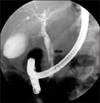Abstract
Biliary cast describes the presence of casts within the biliary tree. It is resultant sequel of cholangitis and hepatocyte damage secondary to bile stasis and bile duct injury. Biliary cast syndrome was first reported in patient undergone liver transplantation. The pathogenesis of biliary cast is not clearly identified, but proposed etiologic factors include post-transplant bile duct damage, ischemia, biliary infection, or post-operative biliary drainage tube. Although biliary casts are uncommon, most of biliary cast syndrome are reported in the liver transplant or hepatic surgery patients. A few reports have been published about non-transplant or non-liver surgery biliary cast. We report two cases of biliary cast syndrome in non-liver surgery patients.
Figures and Tables
 | Fig. 1Ultrasound finding. A hyperechoic double rim layer material was noted on the extrahepatic bile duct (arrow). It was initially thought as ascariasis. |
 | Fig. 2ERCP finding. A longitudinal tubular filling defect was shown on the common bile duct (arrow). |
 | Fig. 3Biliary cast. Dark brown colored cast material was removed endoscopically from the common bile duct. |
References
1. Parry SD, Muiesan P. Cholangiopathy and the biliary cast syndrome. Eur J Gastroenterol Hepatol. 2003. 15:341–343.
2. Waldram R, Williams R, Calne RY. Bile composition and bile cast formation after transplantation of the liver in man. Transplantation. 1975. 19:382–387.
3. Starzl TE, Putnam CW, Hansbrough JF, Porter KA, Reid HA. Biliary complications after liver transplantation: with special reference to the biliary cast syndrome and techniques of secondary duct repair. Surgery. 1977. 81:212–221.
4. Otto G, Roeren T, Golling M, et al. Ischemic type lesions of the bile ducts after liver transplantation: 2 years results. Zentralbl Chir. 1995. 120:450–454.
5. Leung JW, Liu YL, Chan RC, Ling TK, Cheng AF. Effects of adherence factors and human bile on bacterial attachment and biliary stent blockage: an in vitro study. Gastrointest Endosc. 2002. 56:72–77.
6. McMaster P, Herbertson BM, Cusick C, Calne RY, Syrakos T, Marni A. The development of biliary "sludge" following liver transplantation. Transplant Proc. 1979. 11:262–266.
7. Shah JN, Haigh WG, Lee SP, et al. Biliary casts after orthotopic liver transplantation: clinical factors, treatment, biochemical analysis. Am J Gastroenterol. 2003. 98:1861–1867.
8. Canete JJ, Aidlen JT, Uknis ME, Cicalese L. Images of interest. Hepatobiliary and pancreatic: biliary cast syndrome. J Gastroenterol Hepatol. 2005. 20:791.
9. Baron TH, Yates RM 3rd, Morgan DE, Eckhoff DE, Bynon JS. Biliary cast syndrome: successful endoscopic treatment. Gastrointest Endosc. 2000. 52:78–79.
10. Mosca S, Militerno G, Guardascione MA, Amitrano L, Picciotto FP, Cuomo O. Late biliary tract complications after orthotopic liver transplantation: diagnostic and therapeutic role of endoscopic retrograde cholangiopancreatography. J Gastroenterol Hepatol. 2000. 15:654–660.
11. Lim BU, Kim HK, Chae SA, et al. A case of biliary cast with a characteristic finding on ERCP. Korean J Gastrointest Endosc. 2003. 27:254–257.
12. Salmon JM, Read AG. Endoscopic extraction of a calculous bile duct cast formed on a nidus of chromic catgut. Aust N Z J Surg. 1992. 62:498–499.
13. D'Haens GR, Ruchim MA, Goldberg MJ, Baker AL. Massive intra-hepatic and extra-hepatic bile cast formation after cholecystectomy. Gastrointest Endosc. 1993. 39:579–581.
14. Byrne MF, Chong HI, O'Donovan D, et al. Idiopathic cholangiopathy in a biliary cast syndrome necessitating liver transplantation following head trauma. Eur J Gastroenterol Hepatol. 2003. 15:415–417.
15. Gleeson FC, Czaja AJ, Baron TH. Successful endoscopic management of biliary cast syndrome in nonliver transplant patients. J Clin Gastroenterol. 2008. 42:752–755.
16. Hosoi M, Nannya Y, Sasaki T, et al. Biliary cast syndrome and benign biliary stricture as complications of allogeneic hematopoietic stem cell transplantation. Ann Hematol. 2010. 89:1287–1289.
17. Chen CL, Wang KL, Chuang JH, Lin JN, Chu MF, Chang CH. Biliary sludge-cast formation following liver transplantation. Hepatogastroenterology. 1988. 35:22–24.
18. Pfau PR, Kochman ML, Lewis JD, et al. Endoscopic management of postoperative biliary complications in orthotopic liver transplantation. Gastrointest Endosc. 2000. 52:55–63.




 PDF
PDF ePub
ePub Citation
Citation Print
Print




 XML Download
XML Download